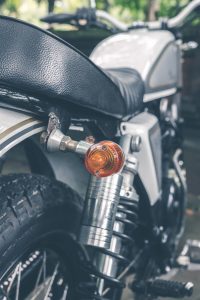 For most of us that ride we want the best of everything, and with good reason. Your bike handling like you expect it to can save your life or if things aren’t right, it can lead to dangerous situations. Few things affect handling like your shocks so looking for the best types of shocks for your bike is a good idea.
For most of us that ride we want the best of everything, and with good reason. Your bike handling like you expect it to can save your life or if things aren’t right, it can lead to dangerous situations. Few things affect handling like your shocks so looking for the best types of shocks for your bike is a good idea.
Before we get into types of shocks we just want to mention something about shock brands. Lots of companies make great shocks and some companies make poor quality shocks. We aren’t here to debate who’s best but to look at what type of shock will work for you.
Most modern bikes today, both for on and off-road have 2 types of shocks:
-
Telescopic shocks
-
Gas-filled shocks.
Unless you ride a sweet vintage bike, you are almost guaranteed to have telescopic shocks on the front of your bike. These compress like an old school pocket telescope with one cylinder sliding into the shock body. In this type of shock, the spring is internal and the shock body is oil-filled.
The rear suspension has a different type of shock that is gas-filled. To get the best cornering stability, weight distribution, and suspension geometry it’s best to just have one shock on the back of your bike. Since this shock is going to be doing the work of 2 in the front, it’s often gas charged. This means high-pressure gas, usually nitrogen, is added on top of the oil to help keep bubbles from forming as things heat up during use.
Since the design of your motorcycle often prohibits changing the style of shock, it’s often better to look at tuning the shocks you have rather than looking for different types of shocks. When it comes to customizing shocks there are really 3 things you can change. The spring rate or type, the oil viscosity, and the compression and rebound settings.
Adjusting the compression and rebound is the trickiest part of dialing your shocks in and takes a little learning and a little feel. For a quick read on how best to do that, check out this article on adjusting the rebound and compression on your shocks.
The next part of adjusting your shocks is choosing the right spring. Spring rates are usually measured in kilograms per inch or pounds per inch and tell you how much force or weight it takes to compress the spring. This decision is left a little bit to the rider’s description but is usually just based on the total weight of the bike and the ride.
Lastly, you can change the viscosity of the oil used in the shock. This is the oil that goes through the damper and slows the rate of travel of the shock cylinder into the shock tube. The thicker the oil, the more damping force you’ll get. It’s a good idea to start with what the factory recommends and make small changes until you get the ride you want.
When looking for different weight oils, look for PJ1 Fork Tuner Oil. PJ1 Fork tuner oil is available in weight ranging from 2.5W up to 30W so you can fine-tune your ride to exactly what you want. It also has maximum wear and water resistance and has a special additive to protect your seals and keep leaks from happening. When you’re ready to get your shocks working perfectly, stop by one of the PJ1 dealers today!
Photo by Artem Beliaikin on Unsplash
